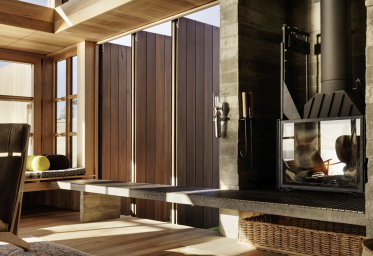
Desert House by Dunn and Hillam architects in Alice Springs uses heat from the ground to keep things cool. Photograph by Kilian O'Sullivan
When we think about sunshine and sustainability we generally think of solar power. Harnessing this abundant resource may have positive impacts on our energy bills and planet but, like our bodies, we need to consider the impacts of the sun on the life-span of our homes and furniture.
Before we delve into the slip, slop, slap of outdoor architecture and design – it is worthwhile looking at where things are headed with solar energy as teams across the world gear up for the fifteenth Bridgestone World Solar Challenge next year.
Of course there are Tesla’s Solar Roof tiles – a range of roofing tiles that incorporate solar cells to generate power for your home without the need for additional installation of large, unsightly solar panels. Made with tempered glass, these tiles are stronger than normal roof tiles and thus come with a lifetime warranty. If you missed it, Tesla and its founder, Elon Musk, are the people driving the electric car revolution and the ones who built the $65.5 million battery for the South Australian government in 2017.

Desert House by Dunn and Hillam architects in Alice Springs. Photograph by Kilian O'Sullivan
Innovations like this and the CSIRO’s 3D printed solar panels are making solar energy production in our homes a lot more attractive and far more flexible. The printed solar panels, created using an electronic ink, are lightweight and can be twisted meaning they can be applied to windows, furniture or any other form that is exposed to sunlight. It is all another step to homes that can power themselves but what of homes that use the sun to remove the need for power?
In Alice Springs a home designed by Sydney-based architects Dunn & Hillam actually uses the sun to naturally cool the dwelling. As we know, hot air rises, and by using the heat captured in the ground below, an up-draught is created that travels through some well-placed windows generating a cooling breeze as the air travels toward the top of the house and back down.
The concept of natural ventilation isn’t new, in fact it is how we kept perishables cool in Australia up until the mid-twentieth century. Now, in architecture, it's known as passive design – a concept used in Melbourne’s Nightingale 1 apartment building which, remarkably, has no need for air-conditioning through the combination of natural cooling with double glazed windows.
Popular in Europe, double glazed windows create a thermal and sound barrier – keeping the heat in, and cold and noise out, though in the Australian summer the effect on temperature is reversed, keeping the cool indoors. There is also UV resistant glass or solar control films available to reduce both the heat from the sun and damage to furniture and artwork though when it comes to the outdoors, we're a little more exposed.

Simon Ancher's Claudio Alcorso memorial bench at Hobart’s MONA uses Celery Top Pine to achieve it's sustainable curves.
Timber in particular feels the effects of changes in temperature as Tasmanian designer Simon Ancher knows all too well. His Claudio Alcorso memorial bench at Hobart’s MONA comprises twisted timber slats that have been in the elements for fourteen years. Ancher’s choice of timber for this project was celery top pine, a class 2 blonde timber popular with boat builders for its durability and ability to deal with both the sun and the water.
Timbers are classed based on their life expectancy with class 2 meaning you can expect over 30 years of outdoor use from celery top pine and up to 25 years when it is submerged in the ground as decking posts or fencing. CTP, as it is known, is a dense timber that is easy to work with, dimensionally stable and has a high resistance to rotting. Qualities that see it being used in park benches across Melbourne and Hobart.

Using Hydrowood Celery Top Pine, these clever public seats in Hobart's Franklin Square double as storage lockers for the outdoor chess pieces.
Ideal for bending, as is the case with Ancher’s bench, the timber settles into its new form over time and is also perfect for steam bending, where the structure of the timber is changed using steam and pressure. As Ancher points out, 'It holds its shape and doesn’t flex back which can cause cracking and distortion even in diverse climates'.
While the rise of ‘timber’ made of recycled plastic bags is appealing – the nature of the plastics don’t hold the same in-built stability as timber, warping in hot conditions. Not great for a new deck or privacy screen.
At the end of the day, and with the summer months ahead, it's important to consider how we can embrace this natural energy source as much as we need to protect ourselves from it.
FOR MORE INFORMATION ON HYDROWOOD CLICK HERE
_
HOUSELAB HINTS
- CTP is a sustainable timber with high durability and resistance to rot
- Another type of timber that is both durable and sustainable and ideal for external cladding is spotted gum
- Timber is now becoming more commonplace for entire building structures, the most obvious species choice for framing is radiata pine
WRITTEN BY HouseLab






